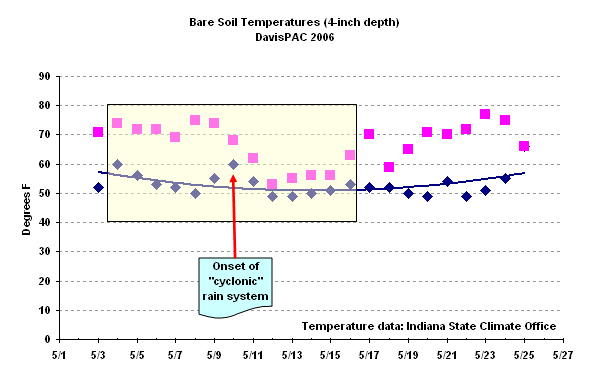

![]() f
you've been walking your fields lately, it is no surprise that much of what
planted during the 5 days or so before the onset of nearly 10 days of cyclonic
rain quite honestly looks like crap (my favorite technical term that describes
a generally poor appearance of a corn crop). Corn planted nearly two weeks ago
around the state is just now beginning to emerge and doing so very erratically.
As I fearmongered two weeks ago (Nielsen,
12 May 2006), the causes of the problems are multiple and include dense
soil surface crusts restricting coleoptile emergence, seed rots, seedling blight,
chilling injury, stress from saturated soils, and some soil-borne insect damage.
f
you've been walking your fields lately, it is no surprise that much of what
planted during the 5 days or so before the onset of nearly 10 days of cyclonic
rain quite honestly looks like crap (my favorite technical term that describes
a generally poor appearance of a corn crop). Corn planted nearly two weeks ago
around the state is just now beginning to emerge and doing so very erratically.
As I fearmongered two weeks ago (Nielsen,
12 May 2006), the causes of the problems are multiple and include dense
soil surface crusts restricting coleoptile emergence, seed rots, seedling blight,
chilling injury, stress from saturated soils, and some soil-borne insect damage.
It is likely that corn planted just prior to the decrease in soil temperatures experienced varying degrees of chilling injury (Saab & Butzen, 2006) during the initial stages of the germination process due not just to the drop in soil temperature itself, but the fact that the sub-optimal temperatures lingered for nearly a week after many of these fields were planted. The accompanying figure illustrates the approximate 10 degree (F) drop in both daily maximum and minimum soil temperatures for nearly six days at the Davis-Purdue Ag. Center in eastern Indiana (Randolph Co.). Chilling injury can result in seeds swollen but not germinated, deformed growth of the mesocotyl (corkscrewing), or visibly damaged areas of the mesocotyl or coleoptile.

Two of the more interesting symptoms being reported are the loss of either the radical root or mesocotyl + coleoptile. By "loss", I mean the fact that these plant parts are sometimes completely absent or are present but easily broken off due to severe deterioration of the plant tissue at the point where they connect to the embryo of the kernel. It is not clear whether the cause is simply disease or possibly chilling injury or both. What is interesting is that initial appearance of the plant parts does not immediately signal a problem, but subsequent handling of the seedling often results in the breakage of the plant part from the seedling. The loss of the radical root does not necessarily mean death to the seedling, but loss of the mesocotyl + coleoptile is obviously lethal.
Additionally, the lengthy period of saturated soils during the early stages of germination and emergence likely stressed the seedlings by virtue of oxygen deprivation. Seed and/or seedling diseases were likely not an issue initially due to the protection afforded by the fungicidal seed treatments, but as their activity deteriorates the "door is opening" for soil-borne diseases to attack the kernels, seed roots, and mesocotyls.
Similar to parts of Indiana in 2005, severe soil crusting has added to the woes of an emerging corn crop. The impact of a soil crust on emergence is most evident when it develops prior to the initial elongation of the "spike" or mesocotyl + coleoptile. Rotary hoes have already been in use across the region with varying degrees of success in breaking up the crust. Some folks have taken the planters back to the field and run them shallowly over the existing furrow to break the crust. Of course, the challenge with this strategy is to balance the benefit of breaking the crust while avoiding damage to the emerging seedlings.
Many growers are faced with the challenge of accurately assessing the extent and health of surviving stands in order to make a reasoned replant decision (Nielsen, 15 May 2006). The challenge lies in the fact that germination and emergence have been so very slow in response to the dramatic cooling down of soils that occurred with the arrival of the rains on 10 May.
Growers should also remember that slow germination and emergence by itself does not automatically translate to a failed stand. The number of heat units (GDDs) from planting to emergence typically ranges from 100 to 125 (modified 86/50 cutoff method). Corn planted on 8 May in eastern Indiana, for example, only just reached that GDD range by about 22 May (GDDs based on soil temperature). IF (note the emphasis on "if") such delayed seedlings are otherwise healthy, they will likely develop into normal plants.
The bottom line is that until emergence is complete, it is nearly impossible to accurately estimate effective (healthy and vigorous) plant populations across entire fields. With the current warming trend, growers should be in a better position by the end of this week (Memorial Day weekend) to make these important stand assessments.
Nielsen, RL (Bob). 12 May 2006. Take Time to Evaluate Corn
Stand Establishment. Corny News Network, Purdue Univ. Online at http://www.kingcorn.org/news/articles.06/CornStandEval-0512.html
[URL verified 5/25/06].
Nielsen, RL (Bob). 15 May 2006. Corn Replant Decision-Making.
Corny News Network, Purdue Univ. Online at http://www.kingcorn.org/news/articles.06/Replant-0515.html
[URL verified 5/25/06].
Nielsen, RL (Bob). 16 May 2006. Late Planting/Replanting &
Relative Hybrid Maturity. Corny News Network, Purdue Univ. Online at http://www.kingcorn.org/news/articles.06/HybridMaturity-0516.html
[URL verified 5/25/06].
Saab, Imad and Steve Butzen. 2006. Diagnosing Chilling and
Flooding Injury to Corn Prior to Emergence. Pioneer Hi-Bred Int’l. Online
at https://www.pioneer.com/growingpoint/agronomy/library_corn/crop_injury/flooding_injury.jsp
[URL verified 5/25/06, but requires free online registration to view].
© 2006 , Purdue University, an equal access, equal opportunity university. This material may be available in alternative formats. If you have trouble accessing this page because of a disability, please contact RLNielsen at rnielsen@purdue.edu.